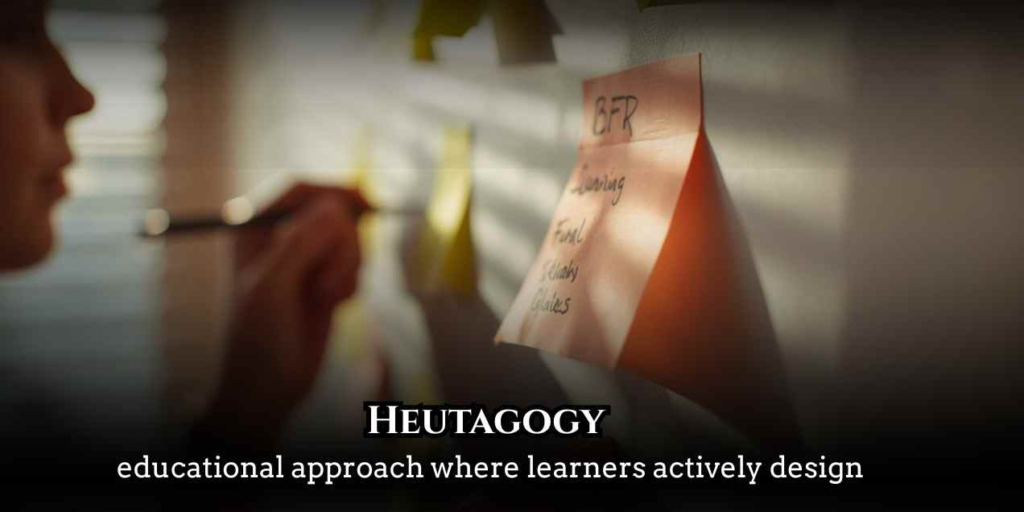In today’s rapidly evolving world, Heutagogy is emerging as a transformative learning approach that shifts the focus from teacher-led instruction to learner-driven education. Unlike traditional pedagogy, Heutagogy empowers individuals to take charge of their own learning journeys, fostering deeper understanding and real-world problem-solving skills. This article explores the definition, history, importance, benefits, and challenges of Heutagogy. It also highlights real-world examples of how this self-determined learning model is reshaping education in schools, universities, and workplaces. Whether you’re an educator, student, or lifelong learner, understanding Heutagogy can help you embrace a more autonomous and future-ready learning mindset.

Understanding Heutagogy
Heutagogy, also known as self-determined learning, is an educational approach where learners actively design, direct, and evaluate their learning processes. Unlike pedagogy (teacher-centered) or andragogy (learner-centered but guided), heutagogy gives full agency to the learner.
Key elements of heutagogical learning include:
- Learner autonomy where students set their own goals
- Flexible learning paths driven by curiosity and context
- Reflection and critical thinking for deeper knowledge building
- Collaborative and experiential learning environments
The approach focuses on developing capability, not just competency. Capability involves applying skills in novel situations, adapting to change, and continuously learning traits essential in a fast-changing global landscape
The Historical Background of Heutagogy in Education
The term Heutagogy was first introduced in 2000 by Stewart Hase and Chris Kenyon. They proposed it as a natural progression from andragogy to meet the demands of the digital and knowledge-based era. Their work emphasized that modern learners need more than guided instruction they require the freedom to learn how to learn.
While its roots lie in adult education and professional development, heutagogy has increasingly influenced higher education, online learning, and corporate training. The rise of technology, open educational resources, and self-paced learning platforms has accelerated its adoption globally.
Why Heutagogy Matters in Modern Education
In the 21st century, the skills most in demand such as problem-solving, adaptability, and lifelong learning can’t be cultivated through rigid curricula alone. Heutagogy plays a crucial role by:
- Encouraging ownership of learning
- Fostering innovation and creativity
- Enabling learners to adapt to complex real-world challenges
- Supporting personalized learning journeys that respect individual pace and interest
In both academic and professional settings, heutagogical methods align with project-based learning, blended learning, and self-directed study models, making them ideal for future-focused education systems.
Benefits of Heutagogy for Learners and Educators
Implementing Heutagogy in education offers multiple advantages that extend beyond traditional learning outcomes:
For Learners:
- Develops critical thinking and problem-solving abilities
- Encourages lifelong learning habits
- Builds confidence and motivation through self-direction
- Enhances digital literacy through exploration of diverse tools
For Educators:
- Shifts the role from instructor to facilitator
- Allows flexibility in curriculum design
- Promotes innovative assessment strategies, such as portfolios and reflective journals
- Cultivates a dynamic learning culture that values curiosity and initiative
By integrating heutagogical principles, educators create spaces where students thrive as active participants rather than passive recipients.
Challenges and Considerations in Applying Heutagogy
While the benefits are significant, implementing Heutagogy also brings challenges that require thoughtful planning:
- Learner readiness: Not all students are immediately prepared for self-determined learning
- Institutional structures: Traditional systems may resist flexible learning models
- Assessment complexities: Measuring capability and self-direction requires innovative evaluation tools
- Teacher preparation: Educators need training to shift from directive roles to facilitative ones
Overcoming these challenges involves gradual integration, strong support systems, and building a culture that values learner agency. Schools and organizations often begin with blended models, combining heutagogical and traditional methods to ease the transition.
Real-World Examples of Heutagogy in Action
Heutagogy is no longer confined to theory it’s actively shaping learning experiences worldwide.
Higher Education Institutions
Many universities are adopting project-based curricula and open-ended assessments, allowing students to design their own research questions and learning paths. For example, some courses enable students to propose final project topics that reflect their passions, demonstrating heutagogical principles in practice.
Corporate Learning Environments
Companies increasingly use heutagogical methods for employee upskilling. Instead of standardized training modules, employees access curated learning resources and choose their own learning trajectories, leading to better engagement and performance.
Online Learning Platforms
MOOCs and self-paced platforms like Coursera and Udemy naturally embody heutagogy by giving learners complete control over pace, sequence, and exploration, empowering millions of learners globally.
These real-world examples highlight the practicality and adaptability of heutagogy across diverse learning contexts.
Future of Education with Heutagogy
As education continues to evolve, Heutagogy is positioned as a key driver of innovation. With advancements in AI-driven learning tools, personalized education, and open-access content, self-determined learning will become more accessible and impactful.
Institutions that embrace heutagogical practices are likely to produce resilient, independent, and adaptive learners who can thrive in uncertain futures. The future classroom may be less about lectures and more about co-creation, exploration, and collaboration.
Conclusion
Heutagogy is more than just an educational theory it’s a mindset shift that empowers learners to become active architects of their knowledge. By understanding its definition, benefits, challenges, and applications, educators and learners can leverage heutagogy to build future-ready learning ecosystems. As the world continues to change, embracing heutagogy offers a powerful path to lifelong learning and innovation. Explore heutagogical strategies in your learning environment and witness the transformation firsthand.
